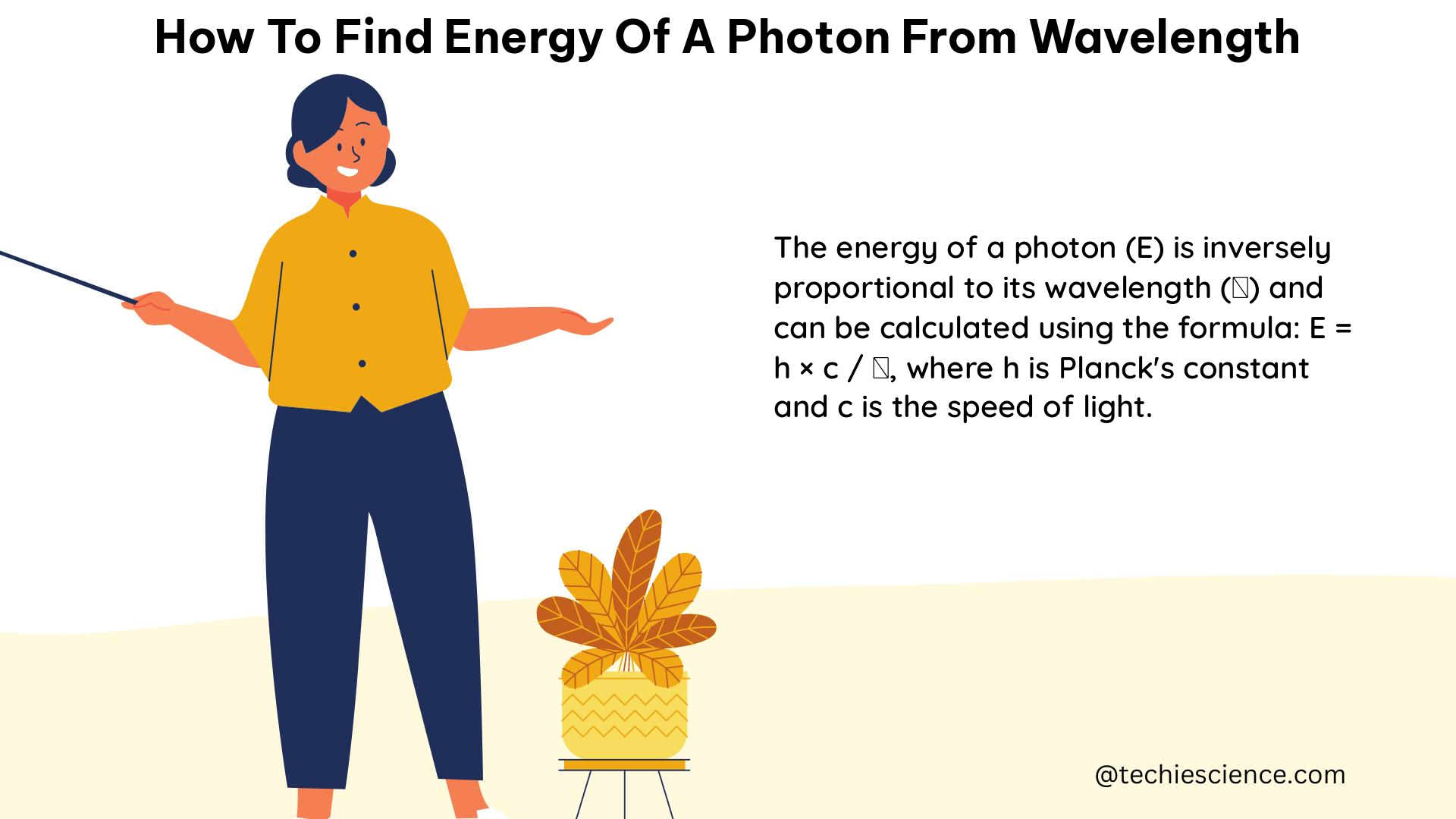The energy of a photon is a fundamental property that is directly related to its wavelength. Understanding how to calculate the energy of a photon from its wavelength is crucial in various fields of physics, from quantum mechanics to optics and spectroscopy. In this comprehensive guide, we will delve into the details of the Planck-Einstein relation, which is the key to unlocking the energy of a photon given its wavelength.
The Planck-Einstein Relation
The Planck-Einstein relation is a fundamental equation that connects the energy of a photon (E) to its wavelength (λ). The formula is:
E = h × c / λ
Where:
– E is the energy of the photon, measured in joules (J)
– h is Planck’s constant, which is approximately 6.63 × 10^-34 J⋅s
– c is the speed of light, which is approximately 3.00 × 10^8 m/s
– λ is the wavelength of the photon, measured in meters (m)
This equation is derived from the principles of quantum mechanics and is a cornerstone of our understanding of the behavior of light and other forms of electromagnetic radiation.
Understanding the Variables

Let’s take a closer look at the variables involved in the Planck-Einstein relation:
Energy (E)
The energy of a photon is the fundamental quantity we are interested in calculating. It is measured in joules (J), which is the standard unit of energy in the International System of Units (SI).
Planck’s Constant (h)
Planck’s constant, denoted as “h,” is a fundamental physical constant that represents the smallest possible change in energy. It has a value of approximately 6.63 × 10^-34 J⋅s, and it plays a crucial role in quantum mechanics and the behavior of subatomic particles.
Speed of Light (c)
The speed of light, denoted as “c,” is another fundamental physical constant that represents the maximum speed at which all electromagnetic radiation, including visible light, can travel in a vacuum. Its value is approximately 3.00 × 10^8 m/s.
Wavelength (λ)
The wavelength of a photon, denoted as “λ,” is the distance between two consecutive peaks or troughs of the electromagnetic wave. It is measured in meters (m) and is inversely proportional to the energy of the photon.
Calculating the Energy of a Photon
Now that we understand the variables involved, let’s walk through an example of how to calculate the energy of a photon given its wavelength.
Suppose we have a photon with a wavelength of 520 nanometers (nm). First, we need to convert the wavelength to meters:
1 nm = 1 × 10^-9 m
520 nm = 520 × 10^-9 m = 5.20 × 10^-7 m
Now, we can plug the values into the Planck-Einstein relation:
E = h × c / λ
E = (6.63 × 10^-34 J⋅s) × (3.00 × 10^8 m/s) / (5.20 × 10^-7 m)
E = 3.82 × 10^-19 J
Therefore, the energy of a photon with a wavelength of 520 nm is approximately 3.82 × 10^-19 joules.
Practical Applications
The ability to calculate the energy of a photon from its wavelength has numerous practical applications in various fields of science and technology:
-
Spectroscopy: Spectroscopy is the study of the interaction between matter and electromagnetic radiation. By analyzing the wavelengths of light absorbed or emitted by atoms or molecules, scientists can determine the energy levels of the system and gain insights into its structure and composition.
-
Laser Technology: Lasers are devices that emit coherent, monochromatic light. The energy of the photons emitted by a laser is directly related to the wavelength of the light, which is a crucial parameter in the design and operation of laser systems.
-
Photovoltaics: Solar cells, or photovoltaic devices, convert the energy of photons into electrical energy. The energy of the photons absorbed by the solar cell material determines the maximum voltage and current that can be generated, which is essential for the efficiency and performance of solar energy systems.
-
Medical Imaging: Certain medical imaging techniques, such as X-ray and positron emission tomography (PET), rely on the interaction of high-energy photons with biological tissues. Understanding the energy of the photons involved is crucial for optimizing the imaging process and minimizing the radiation exposure to patients.
-
Quantum Computing: In the field of quantum computing, the energy of photons is a key factor in the manipulation and control of quantum states, which are the fundamental building blocks of quantum information processing.
Conclusion
The Planck-Einstein relation is a powerful tool for understanding the energy of photons and its relationship to their wavelength. By mastering the concepts and equations presented in this guide, you will be well-equipped to tackle a wide range of problems and applications in physics, optics, and beyond. Remember to always double-check your units and conversions to ensure accurate results, and don’t hesitate to refer back to this comprehensive guide whenever you need to calculate the energy of a photon from its wavelength.
Reference:
- https://www.studysmarter.co.uk/explanations/physics/wave-optics/energy-of-a-photon/
- https://www.youtube.com/watch?v=RvYl36BoYks
- https://www.youtube.com/watch?v=PYNSopwd1l4
- https://405nm.com/how-to-calculate-energy-from-wavelength/
- https://study.com/academy/lesson/energy-momentum-of-a-photon-equation-calculations.html

The lambdageeks.com Core SME Team is a group of experienced subject matter experts from diverse scientific and technical fields including Physics, Chemistry, Technology,Electronics & Electrical Engineering, Automotive, Mechanical Engineering. Our team collaborates to create high-quality, well-researched articles on a wide range of science and technology topics for the lambdageeks.com website.
All Our Senior SME are having more than 7 Years of experience in the respective fields . They are either Working Industry Professionals or assocaited With different Universities. Refer Our Authors Page to get to know About our Core SMEs.